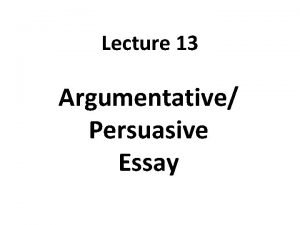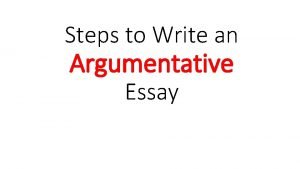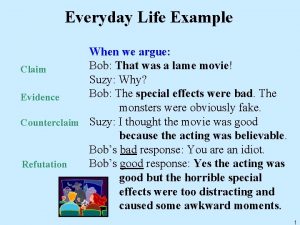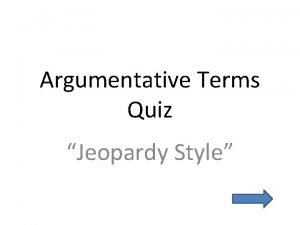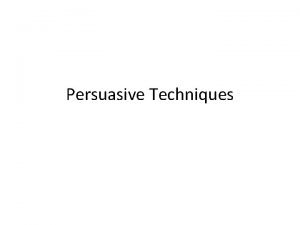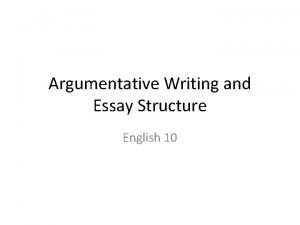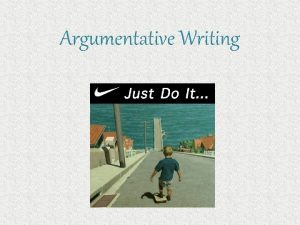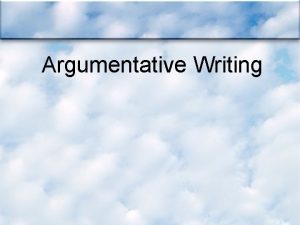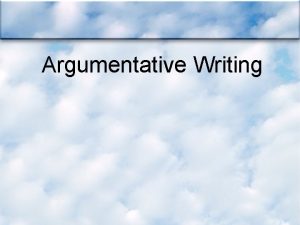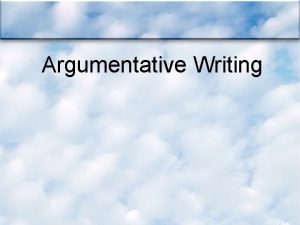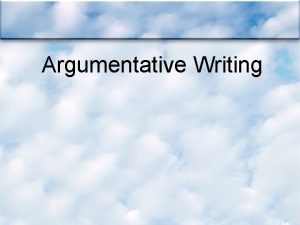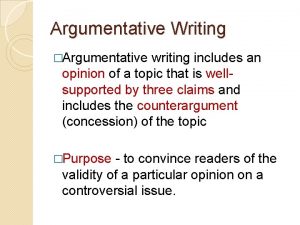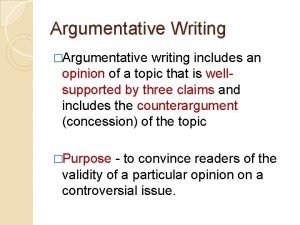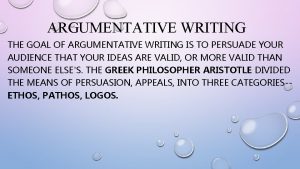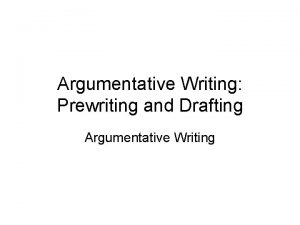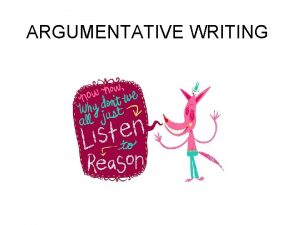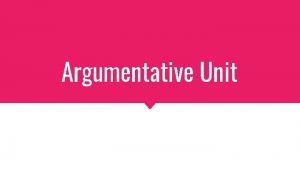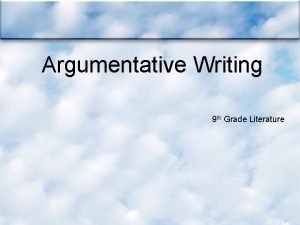Argumentative Writing Unit What is argumentative writing Argumentative



















![Rebuttal Examples • What this argument [overlooks/fails to consider/ does not take into account] Rebuttal Examples • What this argument [overlooks/fails to consider/ does not take into account]](https://slidetodoc.com/presentation_image_h2/8252c41e0f6d79bc091766796e95e35e/image-20.jpg)





- Slides: 25

Argumentative Writing Unit

What is argumentative writing? • Argumentative writing is when an author (you): – Researches a topic – Takes a position/forms an opinion on the topic – Justifies his/her position using evidence • The essay should include: – Argument – Claims – Evidence and reasoning

You will see this type of essay A LOT! • In school – English – History – Science – health • Outside of school – Letters of Recommendation – News articles – Political speeches/advertisements – Closing arguments in trials

Argument (Included in Introduction) Claim 1 (body) Evidence & Reasoning Claim 2 (body) Evidence & Reasoning Claim 3 (body) Evidence & Reasoning Counterargument and Rebuttal Evidence & Reasoning Conclusion Evidence & Reasoning

What is a claim? • A claim is what you believe and what you want your readers to believe. • Your stance on the issue or topic.

Writing a good argument • You MUST start out with a solid claim. • Evaluate your claim – Is it valid? – Is it precise? – How can it be improved? Note: when writing your paper, do not use the word “I”

Testing the strength of your claim • Perform the “weight test” – Can you back it up with data or facts (evidence) – You should have at least 3 solid reasons to support your claim – This requires research!!!

Linking claims and evidence • You need to link your claims and evidence together – Helps the reader see the connection between the two • How do I do this? – Use transition words that explain how the evidence supports the claim, and why it’s so important – You will be given a list of transition words

Evidence does not equal your explanation!!!! • It is essential! • Do not restate the facts you found, that I’ve already heard as part of your evidence. • Without your explanation – Reader will form their own opinion – Thus, you are not PERSUADING them! – Lose the argument

Counterargument/Counterclaim • The counterclaim is also referred to as the opposing claim. It’s a chance for you to expose any weakness in the other sides argument. • It is the “other side” that may call your argument into question. – It is your job to recognize this claim and then disprove it by providing one more piece of evidence and reasoning to strengthen your claim. – Shows you have looked at both sides. – Shows your credibility

Counterclaim Examples Claim Counterclaim • Fast food restaurants are very unhealthy. • Fast food restaurants offer some healthy options. • Law enforcement cameras are necessary to protect citizens. • Law enforcement cameras can give citizens a false sense of security. • Cell phones can improve student learning. • Cell phones can distract students from their learning.

Introduction • Hook the audience – Surprising fact of statistic – Rhetorical question – Use sensory images – Introduce a dilemma – Use a quote--- do not use the dictionary example! – DO NOT MENTION THE COUNTERARUGMENT! • Thesis – Usually the last sentence in the introduction – Clear position that you will support and develop throughout your paper– AKA your argument/claim – Guides and controls your paper

Body Paragraphs • Begin each body paragraph with a topic sentence. – A topic sentence is the first sentence in a body paragraph that sums up what the paragraph is about. • Evidence and Reasoning – Without it, you will not persuade the audience. • Begin citing your sources as you go.

Linking claims and evidence • You need to link your claims and evidence together – Helps the reader see the connection between the two • How do I do this? – Use transition words that explain how the evidence supports the claim, and why it’s so important – You will be given a list of transition words

Counterargument/Counterclaim • The counterclaim is also referred to as the opposing claim. It’s a chance for you to expose any weakness in the other sides argument. • It is the “other side” that may call your argument into question. – It is your job to recognize this claim and then disprove it by providing one more piece of evidence and reasoning to strengthen your claim. – Shows you have looked at both sides. – Shows your credibility

Counterclaim Examples Claim Counterclaim • Fast food restaurants are very unhealthy. • Fast food restaurants offer some healthy options. • Law enforcement cameras are necessary to protect citizens. • Law enforcement cameras can give citizens a false sense of security. • Cell phones can improve student learning. • Cell phones can distract students from their learning.

Counterargument Topic Sentence • Use words that alert the reader this is not part of the argument. – Many people [believe, argue, feel, think, etc. ] that [state the argument here] – It is often [thought, imagined, supposed, etc. ] that [state the counterargument here]. – It might [seem, appear, look, etc. ] as if [state the counterargument here]. • Opposite of your thesis

Counterargument Examples cont. • Another approach is to mention and expert in the field that disagrees with your argument. – On the other hand, Dr. Richards believes that… – However, Dr. Richards takes the position that…

The Rebuttal • If the counterargument requires careful signaling, so does the rebuttal. • Counterargument=180 degree turn from thesis • Rebuttal= 180 degree turn back to thesis.
![Rebuttal Examples What this argument overlooksfails to consider does not take into account Rebuttal Examples • What this argument [overlooks/fails to consider/ does not take into account]](https://slidetodoc.com/presentation_image_h2/8252c41e0f6d79bc091766796e95e35e/image-20.jpg)
Rebuttal Examples • What this argument [overlooks/fails to consider/ does not take into account] is… • This view [seems/looks/sounds] [convincing/plausible/persuasive] at first but… • While this position is popular, it is [not supported by the facts/not logical/impractical…

The Conclusion • Your last chance to make an impact on your reader. • Don’t restate your reasons. – Boring – Repetitive • Instead, remind them WHY your argument is IMPORTANT.

The Conclusion Continued… • The most effective conclusions circle back to the hook. – Rhetorical Question: give an answer that supports the argument/claim. – Shocking Fact: tell readers the consequences if your claim is not followed through… some of you may have done this in the bodies. – Offer a solution to the problem or an alternative plan. – Give the reader something to think about.

• Don’t introduce any new information. • Summarize key points mentioned in the body paragraphs

Editing

Publishing
 Academichelp.net essay
Academichelp.net essay Argumentative essay vs persuasive
Argumentative essay vs persuasive Unit 6 review questions
Unit 6 review questions Persuasive format
Persuasive format Persuasive essay sentence starters
Persuasive essay sentence starters Argumentative essay goal
Argumentative essay goal Good conclusion examples
Good conclusion examples Introducing a counterclaim
Introducing a counterclaim Expository and argumentative writing
Expository and argumentative writing Argumentative writing graphic organizer examples
Argumentative writing graphic organizer examples Argumentative writing jeopardy
Argumentative writing jeopardy Elements of argumentative writing
Elements of argumentative writing Genre of an essay
Genre of an essay Repetition figure of speech examples
Repetition figure of speech examples What is logic in argumentative essay
What is logic in argumentative essay What is argumentative writing
What is argumentative writing Linking words argumentative essay
Linking words argumentative essay Define argumentative writing
Define argumentative writing Unit surplus dan unit defisit
Unit surplus dan unit defisit Right triangle trigonometry
Right triangle trigonometry Si unit to english unit
Si unit to english unit Unit 1 test algebra 2 answers
Unit 1 test algebra 2 answers Unit cost rekam medis
Unit cost rekam medis Unit process and unit operation
Unit process and unit operation What is unit operation and unit process
What is unit operation and unit process Kerangka konseptual akuntansi pemerintahan
Kerangka konseptual akuntansi pemerintahan
